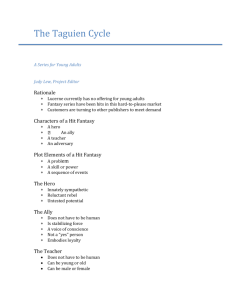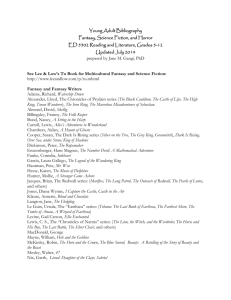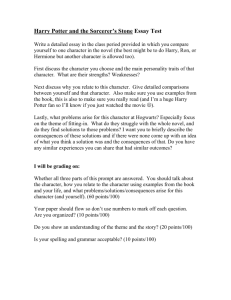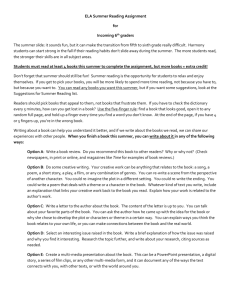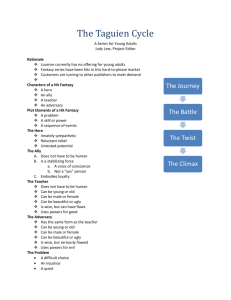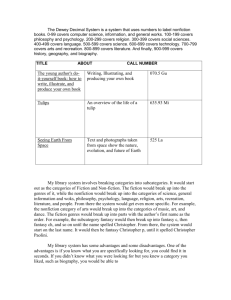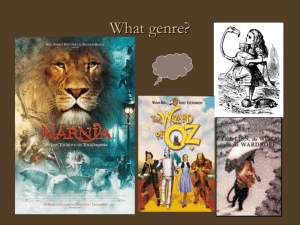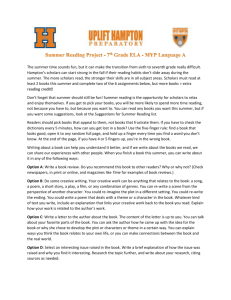Good Fantasy & Bad Fantasy by Gene Edward Veith
advertisement
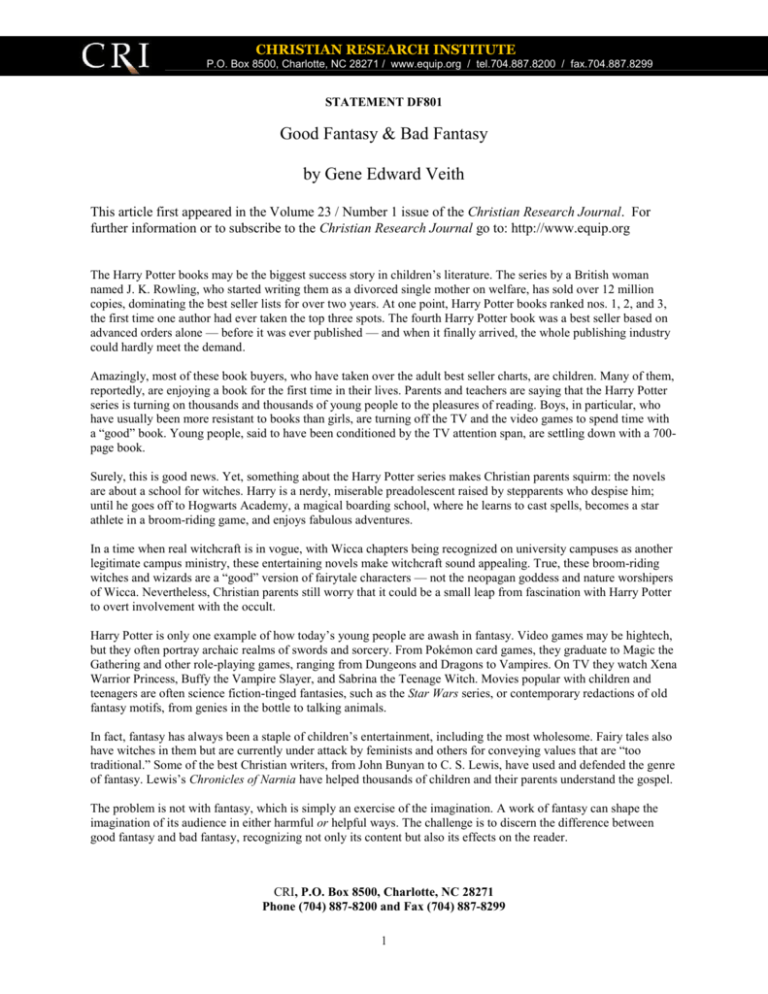
CHRISTIAN RESEARCH INSTITUTE P.O. Box 8500, Charlotte, NC 28271 / www.equip.org / tel.704.887.8200 / fax.704.887.8299 STATEMENT DF801 Good Fantasy & Bad Fantasy by Gene Edward Veith This article first appeared in the Volume 23 / Number 1 issue of the Christian Research Journal. For further information or to subscribe to the Christian Research Journal go to: http://www.equip.org The Harry Potter books may be the biggest success story in children’s literature. The series by a British woman named J. K. Rowling, who started writing them as a divorced single mother on welfare, has sold over 12 million copies, dominating the best seller lists for over two years. At one point, Harry Potter books ranked nos. 1, 2, and 3, the first time one author had ever taken the top three spots. The fourth Harry Potter book was a best seller based on advanced orders alone — before it was ever published — and when it finally arrived, the whole publishing industry could hardly meet the demand. Amazingly, most of these book buyers, who have taken over the adult best seller charts, are children. Many of them, reportedly, are enjoying a book for the first time in their lives. Parents and teachers are saying that the Harry Potter series is turning on thousands and thousands of young people to the pleasures of reading. Boys, in particular, who have usually been more resistant to books than girls, are turning off the TV and the video games to spend time with a “good” book. Young people, said to have been conditioned by the TV attention span, are settling down with a 700page book. Surely, this is good news. Yet, something about the Harry Potter series makes Christian parents squirm: the novels are about a school for witches. Harry is a nerdy, miserable preadolescent raised by stepparents who despise him; until he goes off to Hogwarts Academy, a magical boarding school, where he learns to cast spells, becomes a star athlete in a broom-riding game, and enjoys fabulous adventures. In a time when real witchcraft is in vogue, with Wicca chapters being recognized on university campuses as another legitimate campus ministry, these entertaining novels make witchcraft sound appealing. True, these broom-riding witches and wizards are a “good” version of fairytale characters — not the neopagan goddess and nature worshipers of Wicca. Nevertheless, Christian parents still worry that it could be a small leap from fascination with Harry Potter to overt involvement with the occult. Harry Potter is only one example of how today’s young people are awash in fantasy. Video games may be hightech, but they often portray archaic realms of swords and sorcery. From Pokémon card games, they graduate to Magic the Gathering and other role-playing games, ranging from Dungeons and Dragons to Vampires. On TV they watch Xena Warrior Princess, Buffy the Vampire Slayer, and Sabrina the Teenage Witch. Movies popular with children and teenagers are often science fiction-tinged fantasies, such as the Star Wars series, or contemporary redactions of old fantasy motifs, from genies in the bottle to talking animals. In fact, fantasy has always been a staple of children’s entertainment, including the most wholesome. Fairy tales also have witches in them but are currently under attack by feminists and others for conveying values that are “too traditional.” Some of the best Christian writers, from John Bunyan to C. S. Lewis, have used and defended the genre of fantasy. Lewis’s Chronicles of Narnia have helped thousands of children and their parents understand the gospel. The problem is not with fantasy, which is simply an exercise of the imagination. A work of fantasy can shape the imagination of its audience in either harmful or helpful ways. The challenge is to discern the difference between good fantasy and bad fantasy, recognizing not only its content but also its effects on the reader. CRI, P.O. Box 8500, Charlotte, NC 28271 Phone (704) 887-8200 and Fax (704) 887-8299 1 Harry Potter finally met his match in England when another fantasy character took over at the top of the best seller list. A new translation of the tenth-century Saxon epic, Beowulf, rendered in vivid new prose by the Nobel prizewinning Irish poet Seamus Heaney, also became a literary sensation. Both the new Beowulf and Harry Potter and the Prisoner of Azkaban contended for the prestigious British literary award, the Whitbread Prize. The nine-member panel that awarded the prize argued bitterly about which one was more deserving. A pro-Beowulf critic called the Potter book “derivative, traditional and not particularly well-written.” A pro-Potter voter dismissed Beowulf as “a boring book about dragons.”1 Both Beowulf and the Potter books are about dragons, monsters, and superhuman powers; yet the former is an acknowledged literary classic, while the latter is a controversial children’s book. What is the difference? The Whitbread Prize, by the way, went to Beowulf in a five-four vote. What makes one kind of fantasy superior to another? How can a reader, or the parent of a reader, tell the difference between good fantasy and bad fantasy? Being able to make such judgments involves attention to the worldviews that lie behind the fantasies, an understanding of how fantasy works, and discerning the effects a particular work of fantasy has on the reader.2 Fantasy and Reality The answer is not simply to dismiss fantasy altogether in favor of works that are “realistic.” One could argue that the current wave of realistic children’s books are more negative in their effects than the Harry Potter fantasies. Books such as Heather Has Two Mommies by Leslea Newman and Diana Souza and Daddy’s Roommate by Michael Willhoite are “realistic” attempts to legitimize homosexuality for four to eight year olds. Other works in the genre of realism deal with divorce, child abuse, and sex. Popular titles written for teenagers include sympathetic treatments of drug abuse, running away from home, suicide, and premarital sex of every description.3 Today’s “realistic” world is one of bad parents, moral rebellion, and adolescent self-pity. The vogue for “realism” in children’s books is often a pretext for politically correct indoctrination, antifamily diatribes, and angst-ridden problem narratives. As a literary style, “realism” arose in the late nineteenth and early twentieth centuries as a manifestation of the worldview known as “naturalism.” Authors such as Emile Zola, Frank Norris, and Stephen Crane insisted that writers should concentrate on what is “real” — that is, what can be experienced tangibly and empirically, the material universe explained by Darwin and the social materialism set forth by Marx. Their realism was bleak and depressing, filled with the seamy side of life, purposefully void of ideals, sentiments, morality, and, of course, religious values. The term “realism” begs the question of what one assumes to be real. If one believes that Darwin’s “law of the jungle” is real, then one will write stories about ruthless struggles for survival. A despairing view of reality leads to despairing works of art. Invariably, a particular author’s “realism” is a function of his or her worldview. Moreover, since every work of fiction is, by definition, a made-up imaginary story, every work of fiction, no matter how realistic it seems, is a kind of fantasy. The sunshiny view of homosexuality in Heather Has Two Mommies is written so it seems real, but, in fact, it is a self-conscious projection of the author’s imagination. Because it disregards the truths of God’s commandments from a Christian perspective it distorts rather than reflects reality. In leaving out the spiritual dimension, Zola’s social commentaries may be realistic in their style, but they are not real at all. A realism that confines itself to descriptions of only those things that can be seen in ordinary life necessarily excludes that which remains unseen but which nonetheless gives ordinary life its meaning, namely, truths of morality, faith, and transcendent ideals. The challenge for a Christian writer or artist is how to get at these invisible truths. It is possible to show their effects in a realistic way or to go inside the heart of the characters to show their inner struggles. There are realistic Christian authors, such as Dostoevski, but another way to write about these invisible truths is to explore them symbolically; that is, through fantasy. By definition, fantasy is wholly imaginary. It is not reality, but it can provide a way to think about reality. One of the first explicitly Christian discussions of literature was The Apology for Poetry written in the sixteenth century by the statesman, soldier, man of letters, and devout Protestant, Sir Philip Sidney. He took on the Puritan Stephen Gosson’s charge that poetry — by which he meant creative, imaginative fiction — is a lie, since it recounts things that are not real. CRI, P.O. Box 8500, Charlotte, NC 28271 Phone (704) 887-8200 and Fax (704) 887-8299 2 Sidney argued that imaginative fiction is one of the few expressions that cannot be a lie. “To lie,” he observed, “is to affirm that to be true which is false.” A fiction writer, however, never pretends that his tale actually happened. “He nothing affirms,” said Sidney, “and therefore never lieth.”4 Historians, philosophers, and scientists can hardly avoid lying sometimes — that is, stating something to be true that is really false — even if their lapse is inadvertent. But a fiction writer, by definition and as everyone knows, is working with what is imaginary. He or she is describing not what is or has been but what could be or should be, writing “not affirmatively but allegorically and figuratively.”5 The work of fiction, says Sidney, is “profitable inventions.” It is profitable precisely because it can deal with ideals, “what should be,” and it is especially effective in teaching morality. A good story, Sidney says, both teaches and delights. In other words, it teaches by delighting.6 The Christian psychologist William Kirk Kilpatrick has shown how stories shape children’s moral education. Children are taught the attractiveness of virtue and the repulsiveness of evil not so much by abstract precepts — and certainly not by schools’ “values clarification exercises” — but by rooting for virtuous heroes and being inspired by a good story to emulate their behavior.7 Logically, it seems that the reverse would also be true. If stories can make virtue attractive to some, they can also make vice attractive to others. Like all powerful tools, literature can have a good use or a bad use. If one’s purpose is to teach a child not to lie, nothing beats “The Boy Who Cried Wolf” nor Aesop’s other fables, which, for all of their talking animals, convey true notions of hard work (“The Ant and the Grasshopper”) and persistence (“The Tortoise and the Hare”). Many Christian writers from Dante to J. R. R. Tolkien have, in fact, favored “profitable inventions” over realistic or even nonfictional tales. One reason, lying deep in the biblical imagination, may have something to do with one of the Ten Commandments. The prohibition against making “graven images” specifically forbids the making of “likenesses”: “Thou shalt not make unto thee any graven image, or any likeness of any thing that is in heaven above, or that is in the earth beneath, or that is in the water under the earth” (Exod. 20:4; KJV, emphasis added). For the classical Greeks, who gave us our aesthetic heritage, the essence of art is mimesis, the imitation of external reality. For Plato, the visible world itself is nothing more than an imitation of ideal forms in the transensory realm of ideas. The Hebrews, on the other hand, saw the universe as a creation by a transcendent God. By extension, art is seen as a creation by a human being. The commandment would seem to make realistic art, the aesthetic tradition of mimesis that makes imitations of the external world, problematic. Of course, the commandment is actually aimed at idolatry, “bowing down” to these likenesses as practiced by the pagan nature religions. The Bible, in fact, required that certain kinds of realistic art — renditions of lions, pomegranates, seraphim — be made to adorn the Temple. But the Jews took the prohibition of likenesses to heart. This did not prevent them from making artistic designs, but it did prevent them from making realistic designs. The pottery and coins of early Israel are decorated with nonrepresentational designs — intricate intersecting lines and geometric shapes — which are beautiful, though they are likenesses of nothing in heaven or on earth or in the water.8 The early church attacked the idolatry of classical paganism by insisting that the pagan mythologies were not real but only stories, that is, fantasies. In fact, one could argue that the early Christians invented fantasy — or even invented fiction — by what they did to myth. They taught that the myths were not true, while retaining them in their educational curriculum as pure stories. “It was the Christians,” observes Werner Jaeger, “who finally taught men to appraise poetry by a purely aesthetic standard — a standard which enabled them to reject most of the moral and religious teachings of the classical poets as false and ungodly, while accepting the formal elements in their work as instructive and aesthetically delightful.”9 The pagans did not believe the sagas of their gods were myths. They believed they were true. But for Christians to believe that Icarus actually flew so high on wax wings that they were melted by the chariot of the sun god would be idolatry. Once it is clear that there is no sun god and that this story never really happened, it can be appreciated in a different way as an illustration of what can become of human pride. CRI, P.O. Box 8500, Charlotte, NC 28271 Phone (704) 887-8200 and Fax (704) 887-8299 3 Children who have a strong sense of fictionality and who know that there is a difference between the story and the actual world are inoculated against most of the bad effects of fantasy. It is when the child takes the fantasy world as the real world — that is, when it ceases to be fantasy — that problems can arise. When the child understands the difference between fiction and reality, however, stories of all kinds can both teach and delight. Good Escape and Bad Escape Another Christian defender of fantasy, who himself was one of the greatest fantasy writers of them all, was J. R. R. Tolkien. One charge against fantasy is that it is mere “escapism.” Tolkien, however, pointed out that it is not always morally irresponsible to try to escape. “Why should a man be scorned,” he wrote, “if, finding himself in prison, he tries to get out and go home? Or if, when he cannot do so, he thinks and talks about other topics than jailers and prison walls?”10 There is a difference, he said, between “the flight of a deserter” and “the escape of a prisoner.”11 It is indeed possible to be a “deserter” by using fantasy to escape from one’s true responsibilities and one’s God-given place in life. This would be a misuse of fantasy. But Tolkien was emphasizing the sense in which today’s materialistic worldview — which admits of no God, no immortality, no moral truths, no transcendent ideals — is, in fact, a narrow, stifling prison house. In an intellectual and cultural climate that recognizes nothing beyond what can be seen, touched, and measured, it may take a fantasy — such as Tolkien’s Lord of the Rings — to awaken people’s imaginations to longing, beauty, moral heroism, and transcendent ideals. Working on their imagination in this way might waken a sense in them that there is something more to life than a narrow material universe of buzzing atoms. Part of the problem with today’s variety of unbelief is that people cannot imagine any kind of transcendence. C. S. Lewis, the great Christian apologist whom Tolkien was instrumental in bringing to Christ, cited as a key moment in his spiritual pilgrimage his reading in a railway station the odd adult fairy tale Phantases by the nineteenth century Christian author George Macdonald. “I did not yet know (and I was long in learning) the name of the new quality, the bright shadow, that rested on the travels of Anodos [the main character of the book]. I do now. It was Holiness....That night my imagination was, in a certain sense, baptized; the rest of me, not unnaturally, took longer.”12 Lewis went on to write fantasies himself such as The Chronicles of Narnia. One of the Chronicles, The Voyage of the Dawn Trader, features a boy named Eustace Scrubb, a product of permissive, liberal parents and the modern educational system. Being brought up a thorough-going materialist, he liked only books that were realistic. “He liked books if they were books of information and had pictures of grain elevators or of fat foreign children doing exercises in model schools.”13 When Eustace finds himself in Narnia, with its talking animals and noble ideals, he is utterly lost. Rude, obnoxious, and self-centered, Eustace cannot function in a moral world. Then, he confronts a dragon. Since “Eustace had read none of the right books,” he does not even know what it is.14 “Most of us know what we should expect to find in a dragon’s lair,” writes Lewis, “but, as I said before, Eustace had read only the wrong books. They had a lot to say about exports and imports and governments and drains, but they were weak on dragons.”15 Partly due to this ignorance and to the twisted quality of his own moral nature, Eustace eventually turns into a dragon himself. Finally, the mighty lion, King Aslan, destroys Eustace’s evil nature, and Eustace is reborn, a repentant sinner redeemed and changed by Lewis’s symbol for Christ. Eustace needed to “escape” from his materialistic selfcentered worldliness into the larger, freer, more spacious world — not just of Narnia but of spiritual reality, which, though it cannot be fully seen, can be evoked, experienced, and symbolized. Lewis’s point is that reading “the right books” can equip a child to recognize the dragons that lurk outside and within. The Chronicles of Narnia are some of those “right books” that can shape a child’s spiritual awareness far better than realistic books about grain elevators. G. K. Chesterton wrote about “the ethics of Elfland” and how fairy tales convey a way of thinking that accords well with the Christian worldview: CRI, P.O. Box 8500, Charlotte, NC 28271 Phone (704) 887-8200 and Fax (704) 887-8299 4 There is the chivalrous lesson of “Jack the Giant Killer”; that giants should be killed because they are gigantic. It is a manly mutiny against pride as such....There is the lesson of “Cinderella,” which is the same as that of the Magnificat — exaltavit humiles [the humble will be exalted] [Luke 1:46-56]. There is the great lesson of “Beauty and the Beast”; that a thing must be loved before it is lovable. There is the terrible allegory of the “Sleeping Beauty,” which tells how the human creature was blessed with all birthday gifts, yet cursed with death; and how death also may perhaps be softened to a sleep.16 These lessons are not mere abstract precepts; rather, they are attitudes and insights that sink deep into the imagination and help shape one’s character. The child psychologist Bruno Bettelheim reports how he has found fairy tales useful in treating children scarred by trauma and abuse.17 The “scary parts” of fairy tales, he maintains, anticipate children’s actual fears (as in Hansel and Gretel’s parents’ being unable to provide for them — children do worry about things like that!). They then show how, despite trials (getting lost in the woods) and temptations (don’t eat the candy house!), through courage and virtuous action (Gretel’s out-smarting the witch), they can “live happily ever after.” While much contemporary children’s literature tries to project a “safe” domestic world and insists that even fairy tales have their scary parts and harsh punishments sanitized out of them, Bettelheim takes a different view: Adults often think that the cruel punishment of an evil person in fairy tales upsets and scares children unnecessarily. Quite the opposite is true: such retribution reassures the child that the punishment fits the crime. The child often feels unjustly treated byadults and the world in general, and it seems that nothing is done about it. On the basis of such experiences alone, he wants those who cheat and degrade him...most severely punished. If they are not, the child thinks that nobody is serious about protecting him; but the more severely those bad ones are dealt with, the more secure the child feels.18 The world of the fairy tale is a realm of rigorous moral order. When used rightly, fantasies can help instill that moral order into a child’s personality. Fantasizing Evil Since fantasies can have a beneficial effect in stimulating the imagination in a constructive way, it must also be possible for other fantasies to stimulate the imagination in a destructive way. One tale might convey the attractiveness of moral heroism; another might be an occasion to wallow in evil thoughts. It is not enough just to look at what the story is about. Some parents object to C. S. Lewis’s The Lion, the Witch, and the Wardrobe just because it has a witch in it. Never mind that the book presents the witch as a repellant villain, indeed as a symbol of the devil and his temptations. Never mind that the book is a powerful allegory of the gospel. The mere presence of the witch is assumed to make the book and its readers partake of the occult. One might just as well say that a tract against witchcraft is occult since it mentions the word. Nor is the answer simply to throw out all stories that contain violence. There can be no plot without some kind of conflict. There can be no story in which everyone lives happily ever after. There must be some kind of problem, some obstacle to overcome, some conflict, whether external (good guys vs. bad guys) or internal (the character having to make a decision between two options) or both (the character having to decide which side to be on). Fantasies tend to externalize inner states or to symbolize ideas in concrete form. That means the conflict will usually be presented as external. This is manifested in fights with monsters, in battles, and in chivalrous contests. These can all be characterized as “violence.” Yet without conflict, one can have accounts of only grain elevators. Imaginative wrestling with conflicts is exactly how stories teach morality and build character . Today, it is nearly always the liberal humanists, who deny the real difference and the conflict between right and wrong, who object the loudest to the “violence” in fairy tales. Slaying a dragon violates animal rights; rescuing a princess is sexist. Eustace’s parents, who protected him from books about dragons, were vegetarians and pacifists. Fantasies, along with all literature, must be evaluated according to their meaning and their effect. What does the violence mean? Does it dramatize the conflict between good and evil, or does it glorify the strong terrorizing the weak? CRI, P.O. Box 8500, Charlotte, NC 28271 Phone (704) 887-8200 and Fax (704) 887-8299 5 What is the effect of the violence on the reader? Does it make the reader less likely to hurt people in real life? Or, does it stir up the pleasures of cruelty and sadism? The point of view — that is, the view of the story’s character from whom the narrative is filtered through and with whom the reader is made to identify — is a useful point of analysis. Traditional stories nearly always present the point of view of the “good guy.” (In more complex realistic stories with an internal conflict, the character may not be so simple, and the story may be precisely about a moral struggle. Tragedies show a noble character whose downfall comes from a moral flaw, but in fantasies, the characters are usually more simple.) Contemporary stories, on the other hand, often place the reader with the point of view of a character who is evil. Bram Stoker’s Dracula, the original vampire novel of the nineteenth century, was from the point of view of the virtuous characters who were battling the monster. Dracula was “the other,” who was distant and repulsive. Yet modern vampire treatments, including Anne Rice’s bestsellers and the various role-playing games, typically present the point of view of the vampires. Readers imagine what it is like to sink their teeth into someone and drink their blood. Both Bram Stoker and Anne Rice have written fantasies “about” vampires, but the imaginative experience and the moral effect they create are far different. In today’s video games, a popular format is the “First Person Shooter.” “First Person” refers to the point of view. This type of interactive game presents the action through the eyes of a character within the story, who happens to be the player. The video screen depicts what the character would be seeing. The player is a “shooter” because he or she is put into the role of a killer who strides through a virtual landscape, raising a gun, aiming it at cowering victims, and then blowing them away. Some games are high-tech shooting arcades, pointing at nonhuman targets, whether alien space ships or clearly unreal monsters. Those games are probably relatively harmless. Some First Person Shooters, however, are imaginative re-creations of what it would be like to be a serial killer. Incidentally, as has been well publicized, the Columbine killers liked these kinds of games, and later they re-enacted the games in real life. It is argued that the number of players who actually act out their games in real life is miniscule. Christians, however, know that it is not just actions but the thoughts and imaginations of the heart that are morally corrupting. Jesus Himself emphasized that God judges murderous thoughts as well as murderous actions; that adultery committed “in the heart” violates God’s commandment, even if it is never acted upon (Matt. 5:21-22, 27-28). What we fantasize about — as occasioned by literary experience — is spiritually important. Pornographic imaginings and fantasizing about hurting others are indeed harmful, even if they are never acted out, because they corrupt the heart. Another difference between traditional fantasies and some that are popular today is that the former have clear demarcations between good and evil. Today, the boundary between good and evil is often blurred or erased. Bram Stoker lived in a moral, biblically informed universe — vampires were powerless against crosses or other Christian symbols. Today’s vampire movies usually acknowledge no such authority, with Dracula simply swatting the Crucifix away in one film. Anne Rice goes further, making us feel sympathy for the vampire, who emerges as more “noble” than his victims. Other fantasies — whether in books, films, or videogames — set up a morally neutral universe in which no side is any better than another, with every man and every monster for himself. In still others, evil simply reigns supreme. If fantasy can be used to teach moral truths and carry them into the imagination, it is also possible for fantasy to desensitize the moral imagination. Just as a tale of chivalry can inspire ideals of courage and honor, the Sword and Sorcery sagas of raping and pillaging, with no moral center, can deaden the heart. For Christians, the main concern about certain kinds of fantasy is the danger of occultism. Though fantasy sets up its own self-contained worlds in which marvelous things can occur, preoccupation with magic, spirits, and sorcery can be spiritually deadly. The temptation can be to reverse literary history and turn fantasy back into myth and myth back into paganism. If witches were merely fantasy creations, they would be harmless. But witchcraft is real. Demonism, necromancy, and pagan rituals are not fantasies; they are real. Someone may be fascinated with such things in fantasy literature and then go on to practice them in real life. We now have vampire fans who have graduated from Anne Rice novels to role-playing games to actual drinking of other people’s blood. CRI, P.O. Box 8500, Charlotte, NC 28271 Phone (704) 887-8200 and Fax (704) 887-8299 6 Again, the problem is crossing away from fantasy, what the reader knows to be imaginary, into the actual world, what the reader believes to be real. Being able to tell the difference between fantasy and reality is an essential survival skill. In fact, it is a definition of sanity. Since fantasy grows out of the inner world, its overall danger — when it is dangerous — has to do with the temptation to sink into oneself, to indulge one’s sinful imagination (Gen. 8:21), and to wallow in the darkness of our fallen nature. The pseudorealism of a false worldview also shuts us into darkness. Good fantasy, on the other hand, takes us out of ourselves, countering our darkness with at least a glimpse of the external light. The Case of Harry Potter So what are Christians to think about the Harry Potter sensation? First of all, there is good reason why so many children are enamored with these books, and why they are making so many children excited about reading for the first time. This is a clear symptom of imagination-deprivation. It is also a powerful indictment of our educational system. To use Tolkien’s metaphor, children’s imaginations are imprisoned, and they are right to want an escape. Their schools often lock them into a politically correct curriculum, earnestly trying to inculcate in them a consciousness of “real” and depressing social problems. Their textbooks are materialistic, with science texts asserting the closed naturalistic system of evolution, with history texts attacking even the remnants of American ideals, and with reading texts spinning out “problem” stories and moral dilemmas. No wonder children hate to read. The key to the popularity of the Harry Potter books is not that they are fantasies — there have been many of those that are not nearly so popular — but that they are books about school. Children read about Hogwarts Academy with a sense of recognition. Here are the cliques, the pressures, and above all the struggle for popularity with which they are all too familiar. But here the school is at least interesting. Instead of just making them sit around in groups and sharing their feelings, this school teaches them wonderful things (how to become invisible, how to change things with a magic wand, and how to fly)! Children, especially bright children, can identify with Harry Potter, who at first is trapped in the “muggle” world (the drab ordinary material realm of those who cannot see the supernatural), while alienated in his school and feeling despised even in his stepfamily. It turns out he is really a wizard all along, and at Hogwarts this nerdy kid with glasses even becomes popular! Young Harry Potter fans are not so much fantasizing about witches as they are fantasizing about being popular and successful. The Christian case against Harry Potter is that he is in a school for witches. Christians know that witches are not just fantasy characters, but that they are real; whether as overt Satan worshipers or as the neopagan devotees of Wicca, which in the end amounts to the same thing. Defenders of Harry Potter can point out that the Hogwarts witches have nothing to do with the Wicca or black magic kinds of witches. They are not evil at all, nor do they preach any kind of New Age nature religion. These witches are out of the fairy tales, with brooms and spells, except that they are good (as in the “good witch” in Wizard of Oz). Actually, Harry is learning to be a “wizard,” such as Gandalf in Tolkien’s Lord of the Rings, not a warlock. Still, at a time when witchcraft is becoming a major presence in our youth culture with books about how to be a witch targeted at teenagers, Christians are right to disapprove. In fairy tales, witches are typically “wicked,” reinforcing the clear lines between evil and good, that is, the forces of darkness and the forces of light. Anything that blurs those lines is cause for concern. Harry Potter, however, does not erase the lines completely. There is an overtly evil power in Voldemort: a true wicked witch with whom Harry and his schoolmates are in conflict throughout the series. Some see disrespect for parents in Harry’s bad relationship with his Muggle stepparents, who make him sleep in a closet; but, in fact, Harry’s real parents were killed (by Voldemort), and his love and admiration for them is a major part of his character. So, yes, Harry Potter falls short, though it is not nearly so bad as some (such as the vampire craze or the first person shooters or the how-to witch books). If the book spoke only of wizards — a profession found only in fantasy books CRI, P.O. Box 8500, Charlotte, NC 28271 Phone (704) 887-8200 and Fax (704) 887-8299 7 — rather than the clear-and-present danger of witchcraft, most of the problems would evaporate. Christian parents are right to steer their children away from the series. Yet, if the Potter bug has already bitten their children, they should handle the situation with care. Parents need to make clear that Christians are not Muggles. In other words, Christianity is not a narrow, materialistic, boring worldview such as the one satirized in the Potter novels and taught in today’s schools. It is Christianity that has the open universe with room both for the natural and the supernatural, for the ordinary and the miraculous. It is Christianity that recognizes unseen truths of goodness and beauty and that believes in a genuine battle between the forces of darkness and the forces of light. The account of how God became man in Jesus Christ, defeating Satan and atoning for our sinfulness by dying on the Cross and rising again, is the most wonderful, mindblowing story of all — having the profound advantage of also being true. The Bible asserts it, history confirms it, and the Holy Spirit brings us to believe it. Those who think in biblical terms have a far bigger, more stimulating worldview than any of their materialistic and occult competitors. The best way to inoculate children from being confused by Harry Potter or seduced by the fantasies that are far worse, in addition to giving them a solid grounding in the Word of God, is to expose them to good literature, including good fantasy. To use C.S. Lewis’s terms, a child who knows about dragons — and witches — from “the right books” will know to stay away from them and will know that he or she doesn’t want to become one. Gene Edward Veith is Professor of English at Concordia University-Wisconsin and the culture editor or World Magazine. He is the author of nine books, including Postmodern Times and Reading Between the Lines: A Christian Guide to Literature. 1 Quoted in Hillel Italie, “Will Classic Epic Poem Catch on in U.S.?” Associated Press, Milwaukee Journal Sentinel, 26 February 2000, 6B. 2 Much of what follows is taken from my book, Reading Between the Lines: A Christian Guide to Literature (Wheaton, IL: Crossway, 1990), which discusses the issues in more detail. 3 See, e.g., Norma Fox Mazer’s When She Was Good, about child-abuse and running away; Francesca Block’s Weetcie Bat, about homosexuality; and Brook Cole’s The Facts Speak for Themselves, about murder and pederasty. 4 Sir Philip Sidney, “An Apology for Poetry,” Criticism: The Major Statements, ed. Charles Kaplan (New York: St. Martin’s Press, 1985), 132. 5 Ibid., 133. 6 Ibid., 115. 7 William Kirk Kilpatrick, Psychological Seduction (Nashville: Thomas Nelson, 1983), 105-7. See also his title with Gregory Wolfe, Suzanne Wolfe, and Robert Coles, Books That Build Character: A Guide to Teaching Your Child Moral Values through Stories (New York: Simon & Schuster, 1994). 8 For further development of these points, see my book, State of the Arts: From Bezalel to Mapplethorpe (Wheaton, IL: Crossway, 1991), 145–161. 9 Werner Jaeger, Paideia: The Ideals of Greek Culture, trans. Gilbert Highet (New York: Oxford University Press, 1965), xxvii-xxviii. 10 J. R. R. Tolkien, “On Fairy Stories,” The Monsters and the Critics and Other Essays, ed. Christopher Tolkien (Boston: Houghton Mifflin, 1984), 148. 11 Ibid. 12 C. S. Lewis, Surprised by Joy (New York: Harcourt, Brace, & World, 1955), 179, 181. 13 C. S. Lewis, The Voyage of the Dawn Treader (New York: Collier Books, 1970), 1-2. 14 Ibid., 69. 15 Ibid., 71. 16 G. K. Chesterton, Orthodoxy (London: The Bodley Head, 1908), 73. 17 Bruno Bettelheim, The Uses of Enchantment: The Meaning and Importance of Fairy Tales (New York: Knopf, 1976). 18 Ibid, 141. CRI, P.O. Box 8500, Charlotte, NC 28271 Phone (704) 887-8200 and Fax (704) 887-8299 8
